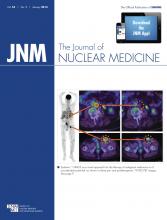TO THE EDITOR: I read with interest the paper of Rapp et al. (1) recently published in The Journal of Nuclear Medicine. The study focused on the discriminatory ability of 18F-FET PET for the initial diagnosis of cerebral lesions suggestive of glioma. The data of 170 patients, excluding 4 with occult glioma, were used for the analysis. Glioblastoma and anaplastic glioma were defined as high-grade gliomas, and other gliomas including diffuse type were defined as low-grade gliomas. The numbers of high-grade gliomas, low-grade gliomas, lymphomas, and nonneoplastic lesions were 66, 77, 2, and 25, respectively.
I have concern about the authors’ statistical procedures, with special emphasis on receiver-operating-characteristic (ROC) curve analysis. The authors set 3 controls—nonneoplastic lesions, low-grade gliomas, and low-grade gliomas plus nonneoplastic lesions—to differentiate neoplastic lesions, high-grade gliomas, and high-grade tumor including lymphoma, respectively. They used the Youden index for cutoff values, which, for maximum and mean tumor-to-brain 18F-FET uptake ratios, were set at 2.5 and 1.9, respectively. The cutoff values were the same for differentiating neoplastic lesions, high-grade gliomas, and high-grade tumor including lymphoma. I think it would be difficult to use these cutoff values for the initial diagnosis of cerebral lesions. In general, patients with nonneoplastic lesions are set as controls, and cases of cerebral neoplastic lesions (total or specific) are determined using maximum and mean tumor-to-brain 18F-FET uptake ratios. The values in Table 2 and Figures 1 and 2 of Rapp et al. indicate a trend toward an increase in maximum and mean tumor-to-brain ratios as the malignancy of glioma progressed. But I feel that the third ROC curve analysis lacks a biologic basis (2). In addition, each area under the ROC curve was less than 0.8, which does not have sufficient statistical significance for satisfactory diagnostic performance in differentiating gliomas using maximum and mean tumor-to-brain 18F-FET uptake ratios.
Before the final conclusion of Rapp et al. on the advantage of 18F-FET PET for initial diagnosis of cerebral lesions is accepted, I strongly suggest further study by adding information on the diagnostic performance of the indicators Rapp et al. used. For example, they could not compare areas under the curve of high-grade gliomas and low-grade gliomas against nonneoplastic lesions by increasing the number of nonneoplastic lesion samples (3). Commercially based software such as MedCalc would be useful for conducting ROC curve analysis.
Footnotes
Published online ▪▪▪.
- © 2014 by the Society of Nuclear Medicine and Molecular Imaging, Inc.







